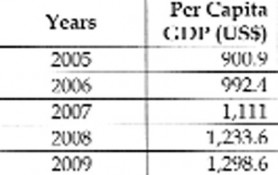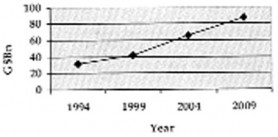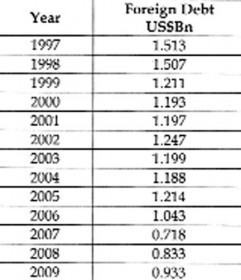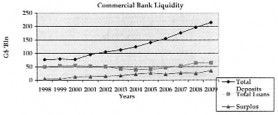Growth in the global economy is expected to be 3.9% in 2010. led by improvements in the financial sector by emerging and developed economies are projected to grow by 6% dominated by China and India.
It is estimated that the Caribbean economies contracted by 2.2% in 2009 and areis projected to grow by 1.8% in 2010.
The Domestic Economy
![]() Half-year decline in real GDP was reported by the Minister of Finance during November at 1.4%, with dismal performance in the agriculture and mining sectors.
Half-year decline in real GDP was reported by the Minister of Finance during November at 1.4%, with dismal performance in the agriculture and mining sectors.
Sugar production increased by 7,469 tonnes or 3.3% over 2008. Production for the first half of 2009 fell short by 19,923 tonnes or 19.3% below the corresponding period in 2008. The second crop produced an increase of 27,392 tonnes over the corresponding period in 2008. In rice, 53,633 tonnes were produced in excess of the projected 306,156 tonnes, attributed to favourable weather conditions and Government’s fertiliser assistance and training programmes.
Mining and quarrying continued with positive growth of 0.7%. Influenced by high international gold prices and suitable weather conditions, raw gold declarations were 299,822 ounces, exceeding the previous year by 14.7%. Diamond declaration however fell by 14.8% to 143,982 carats. Bauxite decreased by 29% continuing from a similar decline in 2008 of 6.7%.
 The manufacturing sector remained stagnant in 2009.Per capita GDP for 2009 was US$1,298.6 compared with US$1,233.66 in 2008, an improvement of 5.3%.
The manufacturing sector remained stagnant in 2009.Per capita GDP for 2009 was US$1,298.6 compared with US$1,233.66 in 2008, an improvement of 5.3%.
Source of information – Budget Speech
Domestic Debt
 The growth in the domestic debt from 1992 to 2009 is shown in the following graph:
The growth in the domestic debt from 1992 to 2009 is shown in the following graph:
Source of information – BOG Statistics – All shown at December except 2009.
External Debt
 The movement in the external debt from 1997 to 2009 is shown in the following table:
The movement in the external debt from 1997 to 2009 is shown in the following table:
Source of information – BOG Statistics and Budget Speech – All shown at December
Balance of payments
 The current account on the balance of payment reflected a surplus of US$234.4Mn in 2009, compared to US$5.6Mn surplus in 2008.
The current account on the balance of payment reflected a surplus of US$234.4Mn in 2009, compared to US$5.6Mn surplus in 2008.
Source of information – Estimates of the Public Sector
The reported private transfers representing remittances and in-kind transfers, amounted to US$299.6Mn in 2009.
Banking and Interest Rates
There was stability in the 91-day Treasury bill rate at 4.18% and the weighted average prime lending rate at 14.54%. On the other hand, the small savings rate declined from 3.04% to 2.78%.
The following table shows the spread earned by the commercial banks as the financial rates continue to decline.
 Not only do many borrowers pay rates higher than the prime lending rate, but banks’ effective borrowing rate is lower than the savings rate as most demand deposit accounts pay no interest. Hence, the significant bank profits which those banks routinely report..
Not only do many borrowers pay rates higher than the prime lending rate, but banks’ effective borrowing rate is lower than the savings rate as most demand deposit accounts pay no interest. Hence, the significant bank profits which those banks routinely report..
Source of information – BOG Statistics
The Exchange Rate
There was a slight appreciation in the value of the Guyana dollar to the US dollar from G$205.25 to G$203.25 per US dollar, or 0.97%.
Ram & McRae’s Comments
 ● Several sector outputs standout in comparison with the prior year as follows:
● Several sector outputs standout in comparison with the prior year as follows:
Source: 2009 and 2010 Budget Speeches
● The results of the diversification of the economy are still not evident two decades after the ERP began. As a result, when agriculture declines, the economy suffers. Transforming the economy cannot mean diverting increasing sums to agriculture each year.
● The two sectors most affected by the global downturn are manufacturing and bauxite, the latter having several years of swings in performance. For a true turnaround in the economy, manufacturing has to show positive gains.
● With industrial action, weather patterns and cash flow difficulties affecting the Guyana Sugar Corporation, it is relying increasingly on budgetary support for its survival.
The reduction in diamond output for five consecutive years is perhaps due to resources being sifted to gold, attracted by by higher prices.
● It appears that the view in the bauxite industry is that the unions are a hindrance to the industry’s success.
● While the exchange rate of the US has improved marginally, the average rate of the major currencies declined.
● The Government continues to ignore employment data. NIS actual contribution data indicate no growth in employment, even as about ten thousand youths leave school annually. In the past five years the number of employed persons increased by 4,632 while the number of self-employed persons decreased by 771.
●Like in the US, the financial sector is outperforming the other sectors. Like in the US, the financial sector benefits form tax shelters so that their effective tax rate is far less than the nominal corporation tax rate of 45%.






